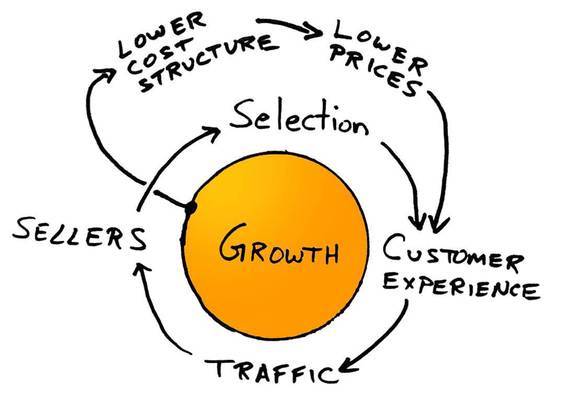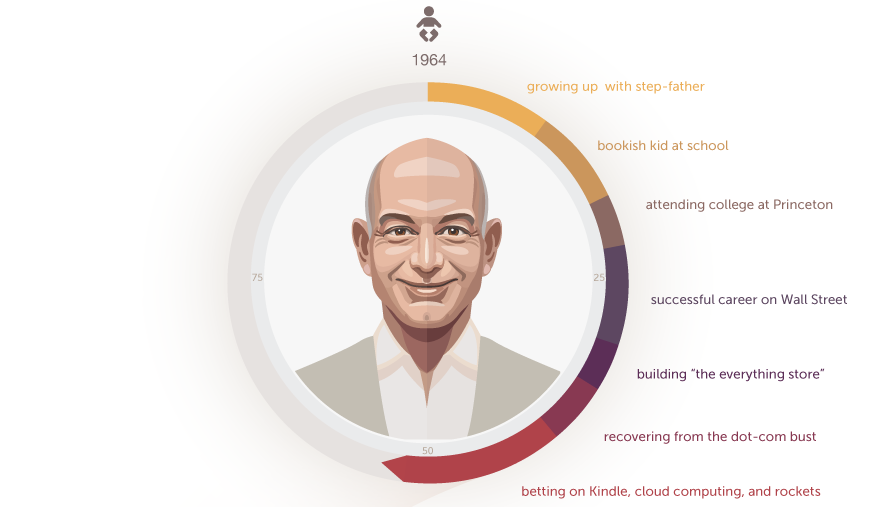Technology
How Jeff Bezos Built his Amazon Empire
On Friday afternoon, Amazon CEO Jeff Bezos briefly passed Warren Buffett to become the world’s third-richest person. Amazon shares have been up 54% since February, propping up his net worth to an impressive $65 billion.
How Jeff Bezos Built his Amazon Empire
Today’s infographic is from Funders and Founders, and it visualizes the career of Jeff Bezos in creating his “Everything Store”.

Image courtesy of: Funders and Founders
While Bezos was ahead of Buffett by about $300 million on Friday afternoon, Amazon’s share price later dipped at the close to erase the lead.
This likely isn’t the last time that a rising Bezos will be biting at the heels of Bill Gates ($88.7B), Amancio Ortega ($73.5B), and Warren Buffett ($65.1B).
How Did Bezos Do It?
“We are willing to be misunderstood for long periods of time.” – Jeff Bezos
Perhaps the most enthralling element of the Jeff Bezos story is his resolute commitment to executing a long-term vision, all while the rest of the world could not comprehend it.
The company ran 20 years without showing signs of significant profit, and it was regularly criticized in the media. Pundits saw Amazon as a growing online book store that couldn’t make money. They didn’t get the bigger picture.
And while the world debated Amazon’s aggressive expansion and polarizing nature, Bezos and his team stayed focused on execution. Even if people didn’t see the vision for the “everything store”, it didn’t mean that Amazon couldn’t build it.
They were willing to be misunderstood for a long time in order to follow the vision – one that was written down by Bezos in a famous napkin sketch:

Image courtesy of: Amazon
Note that in this sketch, which is now over 15 years old, that there is no “take profits” offshoot. It’s a closed loop that uses free cash flow to reinvest back into the established business plan of providing low cost leadership.
And now that Amazon has executed on this plan successfully, it is finally time for profits. That’s why the company had a record quarter earlier this year, and why analysts expect Q2 to be just as impressive.
Watch out Warren, because Bezos isn’t done yet.
Technology
All of the Grants Given by the U.S. CHIPS Act
Intel, TSMC, and more have received billions in subsidies from the U.S. CHIPS Act in 2024.

All of the Grants Given by the U.S. CHIPS Act
This was originally posted on our Voronoi app. Download the app for free on iOS or Android and discover incredible data-driven charts from a variety of trusted sources.
This visualization shows which companies are receiving grants from the U.S. CHIPS Act, as of April 25, 2024. The CHIPS Act is a federal statute signed into law by President Joe Biden that authorizes $280 billion in new funding to boost domestic research and manufacturing of semiconductors.
The grant amounts visualized in this graphic are intended to accelerate the production of semiconductor fabrication plants (fabs) across the United States.
Data and Company Highlights
The figures we used to create this graphic were collected from a variety of public news sources. The Semiconductor Industry Association (SIA) also maintains a tracker for CHIPS Act recipients, though at the time of writing it does not have the latest details for Micron.
| Company | Federal Grant Amount | Anticipated Investment From Company |
|---|---|---|
| 🇺🇸 Intel | $8,500,000,000 | $100,000,000,000 |
| 🇹🇼 TSMC | $6,600,000,000 | $65,000,000,000 |
| 🇰🇷 Samsung | $6,400,000,000 | $45,000,000,000 |
| 🇺🇸 Micron | $6,100,000,000 | $50,000,000,000 |
| 🇺🇸 GlobalFoundries | $1,500,000,000 | $12,000,000,000 |
| 🇺🇸 Microchip | $162,000,000 | N/A |
| 🇬🇧 BAE Systems | $35,000,000 | N/A |
BAE Systems was not included in the graphic due to size limitations
Intel’s Massive Plans
Intel is receiving the largest share of the pie, with $8.5 billion in grants (plus an additional $11 billion in government loans). This grant accounts for 22% of the CHIPS Act’s total subsidies for chip production.
From Intel’s side, the company is expected to invest $100 billion to construct new fabs in Arizona and Ohio, while modernizing and/or expanding existing fabs in Oregon and New Mexico. Intel could also claim another $25 billion in credits through the U.S. Treasury Department’s Investment Tax Credit.
TSMC Expands its U.S. Presence
TSMC, the world’s largest semiconductor foundry company, is receiving a hefty $6.6 billion to construct a new chip plant with three fabs in Arizona. The Taiwanese chipmaker is expected to invest $65 billion into the project.
The plant’s first fab will be up and running in the first half of 2025, leveraging 4 nm (nanometer) technology. According to TrendForce, the other fabs will produce chips on more advanced 3 nm and 2 nm processes.
The Latest Grant Goes to Micron
Micron, the only U.S.-based manufacturer of memory chips, is set to receive $6.1 billion in grants to support its plans of investing $50 billion through 2030. This investment will be used to construct new fabs in Idaho and New York.
-

 Debt1 week ago
Debt1 week agoHow Debt-to-GDP Ratios Have Changed Since 2000
-

 Markets2 weeks ago
Markets2 weeks agoRanked: The World’s Top Flight Routes, by Revenue
-

 Countries2 weeks ago
Countries2 weeks agoPopulation Projections: The World’s 6 Largest Countries in 2075
-

 Markets2 weeks ago
Markets2 weeks agoThe Top 10 States by Real GDP Growth in 2023
-

 Demographics2 weeks ago
Demographics2 weeks agoThe Smallest Gender Wage Gaps in OECD Countries
-

 United States2 weeks ago
United States2 weeks agoWhere U.S. Inflation Hit the Hardest in March 2024
-

 Green2 weeks ago
Green2 weeks agoTop Countries By Forest Growth Since 2001
-

 United States2 weeks ago
United States2 weeks agoRanked: The Largest U.S. Corporations by Number of Employees













